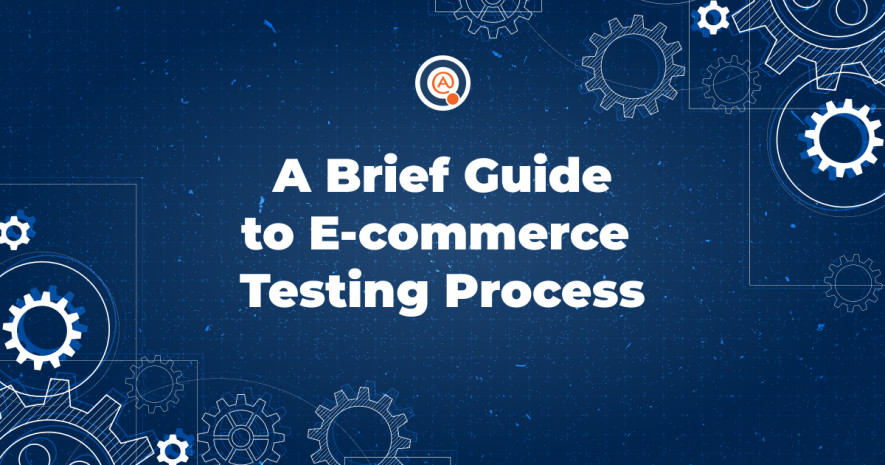- QATestLab Blog >
- QA for Business >
- Industries Insights >
- A Brief Guide to E-commerce Testing Process
A Brief Guide to E-commerce Testing Process

Most people have interacted with e-commerce systems at least once, while for many users, these applications have become a vital part of their daily lives. With over five billion internet users worldwide, the number of people making online purchases is on a constant rise. The rapidly increasing global internet access and adoption are contributing to this trend. In 2023, worldwide retail e-commerce sales were expected to exceed 5.7 trillion U.S. dollars, and this figure is predicted to continue growing in the coming years. When it comes to online shopping, the success of software products depends on various factors, and efficient e-commerce testing is one of them.
Testing plays a crucial role in detecting and resolving potential issues before launching a website. As a significant step in product development, testing has a directly impact on the final quality. It entails assessing different elements of an e-commerce platform to ensure its seamless operation and user satisfaction. Poor quality can lead to underwhelming e-commerce products.
For instance, users expect an immediate response when they click a button. No one wants to waste time. But if the website takes too long to respond, it can be frustrating, and most users will likely move on to another site, remembering the first one as a bad experience. Thus, checking every functional aspect of the website is essential.
This article is a useful resource for developers and business owners who want to improve the quality and reliability of their online stores. By following the advice given in this guide, you can improve your e-commerce platform and provide exceptional value to your customers. This will help you succeed in the ever-changing digital marketplace.
What types of testing are important?
There exist numerous types of testing in the technical space. However, for the e-commerce industry, the following types stand out as the most important:
Functional Testing. The objective of functional testing is to ensure that all aspects of the e-commerce website are functioning correctly. It involves testing features such as searching for products, adding items to the shopping cart, checking out, setting up an account, tracking orders, etc.
Usability and User Experience Testing. These types of testing assess the user-friendliness and overall experience of the website. Usability testing helps identify navigation issues, confusing layouts, and other usability-related problems that could frustrate users and lead to cart abandonment.
Security and Payment Testing. They are used to safeguard user data, particularly during payment transactions, it is essential to conduct testing to detect any vulnerabilities in payment gateways, data encryption, and other security measures. Also, it is crucial to prevent unauthorized access and data breaches.
Performance and Load Testing. These types of testing serve to evaluate how the website performs under different levels of user traffic. Performance testing identifies issues related to slow loading times, unresponsive pages, and potential crashes during high-traffic periods.
Mobile Responsiveness Testing. It is used to confirm that the e-commerce website is displayed and functions correctly on various devices, OS versions, and screen sizes, including smartphones, tablets, and desktops. This testing guarantees a consistent experience for users across different platforms.
Compatibility Testing. This testing includes cross-browser and cross-platform testing. Cross-browser testing prevents issues arising due to inconsistencies in how browsers render web pages and those caused by the different appearance and behavior of software on different devices. In turn, cross-platform testing means testing the same software on different operating systems so that it is displayed correctly on each platform that it is designed for.
Therefore, compatibility testing ensures the smooth operation of the website in such browsers as Chrome, Firefox, Safari, etc., as well as on different operating systems.
Accessibility Testing. This type of testing makes sure the website is accessible to users with disabilities. This testing involves checking compliance with accessibility standards (e.g., Web Content Accessibility Guidelines) to ensure all users can interact with the site effectively.
Localization and Internationalization Testing. For e-commerce websites operating in multiple regions or languages, this testing ensures that content, currency, and other elements are correctly localized and that the website functions well in different cultural contexts.
By utilizing a variety of testing methods, you can guarantee a higher level of quality for your product or platform and prevent any technical issues from happening. In today’s ever-changing online commerce landscape, providing an exceptional customer experience is essential, especially when it comes to catering to our beloved pets.
Let us share an example of how our testing has helped to develop and enhance e-commerce products. We partnered with a high-end pet store and saw great results. Let’s take a closer look at this collaboration.

Your Checklist for E-commerce Testing
There are a wide range of online stores with different sizes and offerings. Some are small businesses that sell their own products, while others are large marketplaces that offer various merchandise, special deals, and constantly updated features. With so many options available, it can be challenging to determine the crucial areas to test to ensure that nothing is missed. To help you with this, we have created a brief checklist that you can save and use to guarantee the excellence of your e-commerce product.
This thorough checklist encompasses different aspects of e-commerce testing to ensure a hassle-free and pleasant shopping experience for users. It also addresses any potential issues that may arise during the online shopping process. Now let’s go into a little more detail:

We would like to invite you to review with us the contents and significance of this checklist with regard to testing:
- Homepage. First, check if the homepage layout is visually appealing and aligns with the brand identity. Ensure that images, banners, and text are displayed correctly. Secondly, test navigation menus and links to ensure users can easily find product categories, deals, and other important sections.
- Search Mechanism. Test the search bar to ensure it accurately displays relevant results based on keywords, product names, or attributes. In addition, verify that users can refine search results using filters and sort products by criteria such as price, popularity, ratings, etc.
- Product List Pages. Ensure that product details, images, prices, and specifications are accurate and well-presented. Remember to test different product variants (e.g., sizes, colors) and options (e.g., quantity) to ensure they are selectable and added to the cart correctly.
- Product detail pages. When viewing product detail pages, it’s important to verify that all product information is presented clearly and completely. Ensure that product images are high quality and can be enlarged for a closer look. Features, customer reviews, prices, and other details should be easily accessible and easily understood. Additionally, check that there are clear buttons for adding items to your cart and sharing on social media.
- Shopping Carts. Test the process of adding products to the cart and verify that quantities and selected options are accurate. Also, check if users can view their cart, edit quantities, and remove items easily. And remember to verify that cart contents are retained even when users navigate away from the cart page.
- Registration. The registration process should be convenient and intuitive for users. Provide an option to create an account via email or social media. During registration, collect only the necessary information, such as name, email address, and password. Also, implement the option of confirming the account via email to ensure the security and confidence of users in their accounts.
- Customer account. A personal user account should provide convenient access to the main functions. Allow users to view and edit their personal data, change their password, specify delivery addresses, check order history, and save their previous settings. It is also important to provide the ability to store favorite products and create wish lists. Provide users with information about promotions, discounts, or personalized recommendations.
- Payments. Test different payment methods (credit/debit cards, PayPal, etc.) to ensure smooth transactions and accurate order total calculation. Additionally, verify the security of the payment process, including data encryption and secure connections. Also, consider ensuring users receive confirmation of successful payment and order placement.
- Recommended Products/Services. Test recommendations based on user browsing history or previous purchases to ensure relevant product suggestions. Verify that recommended products are displayed appropriately on product pages or in the shopping cart.
- After-Order Tests. To ensure a smooth experience for our users, it is important to test whether a user receives emails with order confirmation or a correct receipt and whether it displays accurate order details. It is also crucial to verify that users receive timely notifications regarding order processing, shipping, and delivery.
- Contact Us Page. On the Contact Us page, it is important to test the contact form to ensure that users are able to submit their inquiries and that they are properly directed to the appropriate department. Additionally, verifying the response time for inquiries and confirming that users receive timely and relevant responses is necessary.
- FAQs (Frequently Asked Questions). Review and update FAQ content to ensure it provides accurate and helpful information. Confirm that users can easily navigate and find answers to common questions.

Summing up
Launching a successful online store requires thorough e-commerce testing. Testing ensures a seamless shopping experience, helps to build customer trust, and drives business growth.
By mastering the art of e-commerce testing, you can create an online store that functions flawlessly and delights and retains customers. It includes paying particular attention to stress checking, performance, load, and security testing.
In addition, usability testing is crucial to ensure the product has straightforward navigation and is user-friendly. It is important to note that during holidays, the number of transactions can be huge, making testing even more crucial for success.
Do not hesitate to contact us to explore how independent QA services can benefit your e-commerce software. Leave us a quick message sharing details about your product, and we will design a customized QA solution to fulfill your testing demands.
Learn more from QATestLab
Related Posts:
- Is Your E-commerce Ready for Black Friday & Cyber Monday? Let’s Check!
- Real Cases with E-commerce Platforms Where Software Testing Made a Difference
- Top 7 e-Commerce Industry Trends in 2022







No Comments Yet!
You can be the one to start a conversation.